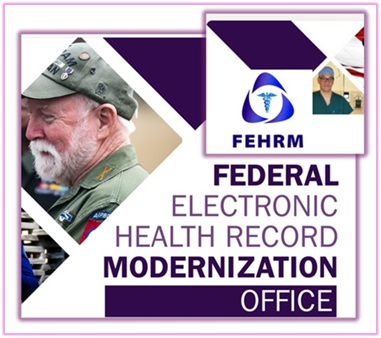
Seamless Care, Unified Vision: A Journey to a Single, Common Federal Electronic Health Record

In my recent interview on The Business of Government Hour with Bill Tinston, Director of the Federal Electronic Health Record Modernization Office (FEHRM), we explored the ambitious effort to implement a single, common Federal Electronic Health Record (EHR) across agencies like the Department of Defense (DoD), Department of Veterans Affairs (VA), Coast Guard, and NOAA. This initiative is a monumental effort to enhance patient care and provider effectiveness by creating a unified, interoperable health record system that prioritizes the patient experience. My conversation with Tinston revealed critical insights into the mission, challenges, and strategies of the FEHRM, offering valuable lessons for leaders navigating complex, large-scale transformations in government or any enterprise setting.
A Patient-Centered, Unified EHR
The core mission of the FEHRM is to implement a single, common EHR that serves federal healthcare beneficiaries—veterans, military personnel, Coast Guard members, and others—across their lifecycle, from active duty to veteran status and beyond. Tinston emphasized that this unified approach is critical because it focuses on the patient, not the organization delivering care. By creating a single longitudinal record, the FEHRM ensures that healthcare providers have immediate access to a patient’s complete medical history, regardless of whether care is delivered at a DoD facility, a VA medical center, or a community provider through the Joint Health Information Exchange (JHIE).
This patient-centered design eliminates the need for patients to carry paper records or navigate fragmented systems when transitioning between agencies or regions. This patient-centered approach ensures that veterans, military personnel, and other beneficiaries experience continuity of care, whether transitioning from active duty to veteran status or moving geographically. For example, a service member moving from the Pacific Northwest to the Southeast, or transitioning to veteran status, benefits from seamless access to their health data. This continuity enhances care quality, reduces administrative burdens, and fosters trust in the healthcare system. Tinston articulated this vision clearly: “We really want to start at the patient [and] make their experience as seamless as possible.” His vision underscores a fundamental principle: technology must serve the human experience, not dictate it.
Strategic Priorities - Building a Patient-Centered Ecosystem
A key priority is achieving operational interoperability among agencies. Tinston emphasized the importance of converging workflows where appropriate to simplify the patient experience: “We converge workflows and processes where appropriate… so that we simplify the patient experience.” This involves aligning DoD and VA processes to ensure the EHR supports integrated care delivery, as demonstrated at the James A. Lovell Federal Health Care Center (FHCC) in North Chicago, the first fully integrated DoD-VA facility.
Another priority is leveraging the EHR’s data to enable future innovations. Tinston highlighted the potential of the system’s comprehensive data store: “We are creating the greatest store of health care data on the planet… the most complete record that’s ever been envisioned.” This data foundation supports advanced technologies like artificial intelligence (AI) and natural language processing (NLP) to enhance provider decision-making and population health research.
Finally, the FEHRM is focused on supporting the VA’s resumed EHR deployments, set to restart in 2026. Tinston noted, “We’re focusing our time right now on anything we can do… to make the VA successful at completing the deployment of the federal electronic health record.” This includes ensuring workflow convergence, enhancing existing sites, and preparing for scalability across the VA’s extensive network.
Leadership Lesson: Align Priorities with Mission
Tinston’s focus on patient-centered care and interoperability underscores a key leadership principle: align strategic priorities with a clear, mission-driven purpose. Leaders must ensure that every initiative serves the end user—in this case, the patient—while fostering collaboration across diverse stakeholders to achieve a unified goal.
Implementation Challenges - Scale, Culture, and Complexity
The FEHRM faces immense challenges due to the scale and complexity of the EHR implementation. With over 200,000 users across 138 DoD facilities, six VA medical centers, 110 Coast Guard sites, and all NOAA locations, the project is “the largest EHR implementation there is,” according to Tinston. The complexity is compounded by the need to integrate commercial off-the-shelf (COTS) software, such as Oracle Health, into diverse federal healthcare systems while ensuring interoperability, user adoption, and cybersecurity: “We have to protect patient data… we have probably the most secure electronic health record that’s ever been created.”
One significant challenge is cultural resistance to change. Tinston candidly acknowledged that implementing a new EHR changes how providers work, sometimes making their jobs harder in the short term. He recounted an instance at the Defense Logistics Agency where 20% of IT staff left because they were unwilling to adapt to a new commercial system. This highlights the human element of transformation—new systems bring new philosophies of work, and not everyone will embrace them.
To address this, Tinston advocates for what he calls “change leadership” rather than traditional change management. He cautioned against superficial efforts: “It’s not about the number of town halls, the number of charts, or the number of posters.” Instead, leaders must engage stakeholders authentically, explaining why changes are necessary and how they benefit patients. At the James A. Lovell Federal Health Care Center (FHCC) in North Chicago, the FEHRM achieved a landmark success by deploying a fully integrated DoD-VA EHR. This was accomplished by fostering collaboration among contractors, health systems, and leadership, all united under a shared goal of patient-centered care.
Leadership Lesson: Change Leadership Requires Authenticity and Engagement
For leaders, Tinston’s approach to change leadership is a masterclass in navigating resistance. Transformation projects often fail when stakeholders feel changes are imposed upon them. By involving users early, soliciting feedback, and aligning changes with a clear mission, leaders can foster buy-in. However, Tinston also acknowledges that not everyone will adapt, and some turnover is inevitable. Leaders must balance empathy with decisiveness, ensuring the organization moves forward while minimizing disruption.
Milestones and Innovations
Despite these challenges, the FEHRM has achieved progress. The DoD has completed its EHR deployment across all 138 military treatment facilities, while the VA has deployed to six medical centers, with 13 more planned for 2026. The Coast Guard and NOAA are fully integrated, and plans are underway to extend the EHR to Coast Guard ships using Starlink connectivity, which Tinston noted has “overcome the problem” of low-bandwidth environments.
The FHCC deployment is a landmark achievement, demonstrating the power of integrated operations. Tinston described it as a transformative success: “We delivered the single electronic health record to them, so they no longer have to [manage multiple systems].” This unified system eliminated inefficiencies, such as providers using separate DoD and VA calendars, and established a baseline for future integrated facilities.
A cornerstone of the FEHRM’s work is the Joint Health Information Exchange, which connects federal healthcare systems with community providers, making it one of the largest health information exchanges in the United States. Tinston described how the JHIE enables seamless data sharing, dwarfing other exchanges in transaction volume. This interoperability ensures that providers have access to comprehensive patient data, even from non-federal systems, reducing delays and improving decision-making. Tinston highlighted its impact: “We are now connected to every electronically connected system… it is extraordinary the information that is exchanged.” This interoperability ensures providers have comprehensive patient data, improving care delivery.
The FEHRM is also exploring artificial intelligence (AI) and natural language processing (NLP) to enhance data usability. These tools can analyze longitudinal health records to provide actionable insights, such as identifying relevant patient data to reduce the cognitive burden on providers. For example, an Air Force doctor told Tinston that not all historical data (e.g., a broken leg at age 12) is equally relevant to current care decisions. AI can help prioritize pertinent information, enhancing provider efficiency and patient outcomes.
Leadership Lesson: Celebrate Milestones, Plan for Scalability, Leverage Data
The FEHRM’s focus on interoperability and data underscores a critical lesson for leaders: data is a strategic asset that can drive innovation and efficiency. By creating a unified data ecosystem, leaders can unlock opportunities for advanced analytics and process optimization. However, this requires robust infrastructure, cybersecurity, and a commitment to making data actionable, not just abundant. Simultaneously, his emphasis on AI and connectivity innovations underscores the need to plan for scalability, ensuring systems can adapt to future needs and technologies.
Mission, Collaboration, and Continuous Improvement
Tinston’s 25 years of experience in enterprise software deployment, primarily in DoD acquisition, inform his leadership approach. He views the EHR as a continuous improvement project rather than a traditional acquisition with discrete phases: “We never go into a sustainment phase. We’re always in a continuous improvement, continuous delivery, continuous integration.” This mindset ensures the system evolves to meet changing needs, avoiding obsolescence.
Collaboration is central to Tinston’s strategy. He described the FHCC success as a result of stakeholders working as a unified team: “We all took our badges off and we were team level team FHCC.” By bringing together contractors (Oracle and Leidos), health systems, and program offices early and often, the FEHRM ensures alignment and shared ownership.
Tinston’s advice to those considering public service is simple: “Do it.” He highlights the unique opportunities to make a meaningful impact, lead mission-driven teams, and serve a greater purpose. His own career, rooted in DoD’s mission-focused culture, demonstrates the rewards of public service, from improving healthcare for veterans to fostering community through shared goals. “A mission focus creates a community. It makes leading easier, especially when you have a mission like healthcare.”
Leadership Lesson: Foster Collaboration and Mission Focus
Leaders managing large-scale projects can learn from Tinston’s rejection of static phases in favor of continuous integration and delivery. This approach requires agility, stakeholder collaboration, and a long-term vision, ensuring systems remain relevant and effective.
Tinston’s emphasis on collaboration and mission focus offers a powerful lesson: leaders must unite diverse stakeholders around a shared purpose. By fostering a sense of community and maintaining a continuous improvement mindset, leaders can drive transformative change, even in the face of complexity.
Navigating the VA’s Strategic Reset
The VA’s temporary halt in EHR deployments, termed a “reset,” allowed the agency to refine workflows, enhance existing sites, and prepare for future rollouts. Tinston noted that this is a common practice in enterprise systems, citing a similar DoD pause in 2017. During the reset, the FEHRM worked to align DoD and VA workflows, ensuring operational interoperability and laying the groundwork for resumed deployments in 2026.
This strategic pause highlights the importance of adaptability. Rather than forging ahead with flawed processes, the VA used the time to strengthen its foundation, demonstrating a commitment to long-term success over short-term progress.
Leadership Lesson: Know When to Pause and Refine
Leaders must recognize when to pause and reassess, especially in complex projects. A strategic reset, when done thoughtfully, can prevent costly mistakes and build a stronger foundation for future success.
The Future: Unlocking New Possibilities
Tinston is optimistic about the future, particularly as the VA resumes deployments. The unified EHR will simplify transitions for service members becoming veterans, integrating exposure data (e.g., PACT Act) to streamline benefits processes. Emerging technologies like Starlink are also expanding connectivity, enabling EHR use in remote environments like Coast Guard ships or disaster zones.
The comprehensive data store created by the FEHRM positions it to leverage AI for population health research and personalized care. By reducing the intellectual burden on providers and enhancing data relevance, the FEHRM aims to transform healthcare delivery.
Conclusion
Some of the core insights shared offer a roadmap for navigating complex, transformative initiatives. By prioritizing patients, fostering change leadership, leveraging data, and embracing continuous improvement, he has guided the FEHRM toward a unified EHR that enhances care for millions. For leaders, the lessons are clear: center the end user, engage stakeholders authentically, harness data strategically, and remain adaptable. Tinston’s efforts illustrate how mission-driven leadership can overcome challenges and help deliver lasting impact.



